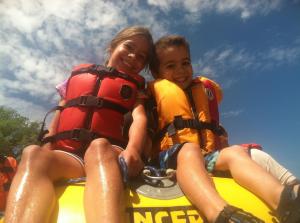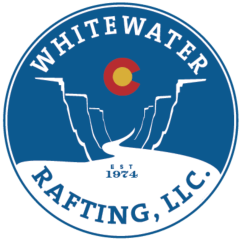When is the Best Time to Go Whitewater Rafting in Colorado?

Summer is great for whitewater rafting in Colorado. There are more than a dozen commercially operated rivers in the state. Generally, rafting season in Colorado starts in late April and runs into early October. However, the heart of summer—June, July, and August— is the best time for Colorado whitewater rafting. Below we’ve summarized what to expect from each part of summer so you can decide for yourself when is the best time to go rafting in Colorado.

Early Season: April, May, and June
Colorado’s winter snow begins to melt as the weather warms in the spring. By late April, rivers are on the rise. Early rafting can be intense after a particularly heavy winter. This is when adventurous paddlers can go rafting on more advanced stretches of whitewater, including Class V spine-tinglers like Dowd Chute on the Eagle River near Vail.
Although the season is relatively short – only a few weeks – Dowd Chute is one of the best in the country. However, water levels can fluctuate daily. For the safety of rafters, professional guides strictly adhere to commercial cut-off limits on the river. Dowd Chute is a physically demanding stretch of whitewater, and all participants must be good swimmers in excellent health with previous rafting experience.
The Lower Eagle River is an excellent choice for families this time of year. Because it’s also fed by snowmelt, it’s only in season for a few weeks but features Class III rapids. The dam-controlled Colorado River is open for rafting when outside temperatures warm, allowing you to raft the Shoshone near Vail and portions of the Upper Colorado River in early summer, too.
Whitewater rafting on the Shoshone section of the Colorado River is great this time of year. This journey will take you through the beautiful Glenwood Canyon, where rock walls overhang the river, and hot springs abound. In addition to breathtaking views, the Shoshone section boasts a mile of Class III rapids and incredible scenery. This river is a wonderful introduction to whitewater rafting and is suitable for all ages. Along the route, you’ll come across plenty of places to take a swim or start a water fight with other boats.
The Upper Colorado River is the best whitewater rafting trip for families with young children, seniors, and anyone looking for a relaxing and easy ride down the river. It is exceptionally scenic. You can spot wildlife and learn about the area’s history, flora and fauna from your guide as you raft the gentle rapids.
Peak Season: June, July, and August
Colorado has long, sunny days and bright blue skies, and the mid-summer climate for rafting is perfect. The list of summer rafting destinations is long and impressive — there are more than 30 major whitewater rafting areas in Colorado. Popular launch locations include Glenwood Springs, Steamboat Springs, Winter Park, Vail, Fort Collins, and southwestern cities like Durango and Buena Vista. Here are our favorite peak-season rafting adventures, in no particular order:
Colorado River
The Colorado River is one of the most famous rivers in the state (nee, the nation). The vast, 1,450-mile river spans seven U.S. states and two states in Mexico. It is responsible for cutting the Grand Canyon in Arizona. In Colorado, rafting on the Colorado River is a must. The river flows through various canyons, with spectacular views, wild rapids, and smooth, calm sections for multiple experiences. Glenwood Canyon is one of the most scenic rafting routes in North America. Breckenridge, Grand Junction, and Glenwood Springs are popular launch points.
Arkansas River
The Arkansas River has a crazy 5,000-foot drop over a span of 125 miles, so it is one heck of a ride. But don’t let that put you off. This famous river is suitable for everyone and has easy stretches for families that are second to none. The views are simply incredible, especially where it meets the Royal Gorge. The Arkansas River is accessible from various points in the state. Many are not far from downtown Denver.
Clear Creek
Clear Creek excels when it comes to convenience. It’s located near Denver in the former mining town of Idaho Springs, just off I-70 to the Vail and Breckenridge ski areas. Clear Creek has day trips from mid-May to mid-August. You’ll find rafting for all levels here, from kid-friendly beginner patches to adventurous challenges up to Class V and some of the most formidable rapids you can conquer.
Roaring Fork River
Roaring Fork is a super convenient stopover from Aspen or Carbondale. The Upper Roaring Fork River is home to the Slaughterhouse (an ominous nickname, for a good reason). These rapids are extreme. But the rewards are worth it. You’ll find one of the state’s rare commercially drifting waterfalls here. You can also go further downstream for a gentler ride. The Roaring Fork winds around 70 miles into the Roaring Fork Valley and ends at Glenwood Springs.
Yampa River
If you’re visiting Steamboat Springs during the summer, visit the Yampa River. The river flows directly through the ski village’s restaurants and bars and winds through the exciting Dinosaur National Monument. With just over 260 miles in length, the Yampa can find rafting tours for all skill levels, including some significant challenges for adrenaline hounds. As the name suggests, this area is full of dinosaur remains you can see in the rocks. Kids love it; it’s a whitewater ride with a prehistoric vibe.
Rio Grande River
Yes – the river that makes up Texas’s southern border with Mexico is raftable in Colorado! The nation’s fifth largest river, the Rio Grande, stretches more than 1,750 miles in Colorado through the scenic San Juan Mountains on its way to the Gulf of Mexico. The “upper box” section of the river is a dream for experienced rafters – Class III to Class V rapids throughout. The “lower box” is much milder and more family-friendly. A popular launching point is Creede, a former mining town.
Late Season: September and October
You might think that the rafting season ends in August. But there are a lot of benefits when drifting late in the season. The whitewater may not be as intense, but there are still many exciting sections of rafting with fewer rafters than during the height of summer. Need more reasons? We have them:
1.A lower water level means you float at a slower speed, taking more time to reach your final destination.
2.Despite the lower water levels, the slope and slope of the river haven’t changed, so you still have to expect big dips.
3.Lower water means fewer big and scary waves! This is the perfect time for families to go down the river without the stress of high tide season.
4.With the heat of July, you can go rafting without being at the sun’s mercy. Bring your sunscreen and hat anyway!
5.During the low season, water levels drop, making sandbars and beaches larger.
6.By late summer, the abundance of wildlife makes many species easier to spot. Keep an eye out for bighorn sheep and other wildlife.
